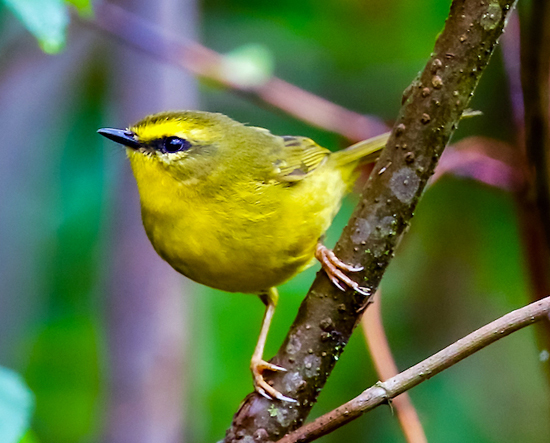- Myiothlypis signata
Myiothlypis signatus
Basileuterus signatus
Identification
13·5 cm (5¼ in)
- Yellow supercilium and lower eye crescent
- Olive-green head and upperparts
- Dark iris
- Black bill
- Yellowish legs
Distribution
South America: found in Peru, Bolivia and Argentina
Taxonomy
Formerly placed in genus Basileuterus.
Subspecies
There are 2 subspecies[1]:
- M. s. signata:
- Andes of central Peru (Junín to Cuzco)
- M. s. flavovirens:
Habitat
Moist montane forests, forest edges; dense undergrowth along streamsides, at heights from 1500 to 3050 m, though generally above 1800m.
Behaviour
Diet
There's not a lot of information available. It is thought they eat mostly on invertebrates, foraging near the ground in the understorey. They will sometimes flycatch.
Breeding
Virtually no information; juveniles observed in December and February in central Peru.
References
- Clements, J. F., T. S. Schulenberg, M. J. Iliff, S. M. Billerman, T. A. Fredericks, B. L. Sullivan, and C. L. Wood. 2019. The eBird/Clements Checklist of Birds of the World: v2019. Downloaded from http://www.birds.cornell.edu/clementschecklist/download/
- Avibase
- Curson, J. (2020). Pale-legged Warbler (Myiothlypis signata), version 1.0. In Birds of the World (J. del Hoyo, A. Elliott, J. Sargatal, D. A. Christie, and E. de Juana, Editors). Cornell Lab of Ornithology, Ithaca, NY, USA. https://doi.org/10.2173/bow.palwar1.01
Recommended Citation
- BirdForum Opus contributors. (2025) Pale-legged Warbler. In: BirdForum, the forum for wild birds and birding. Retrieved 4 May 2025 from https://www.birdforum.net/opus/Pale-legged_Warbler




